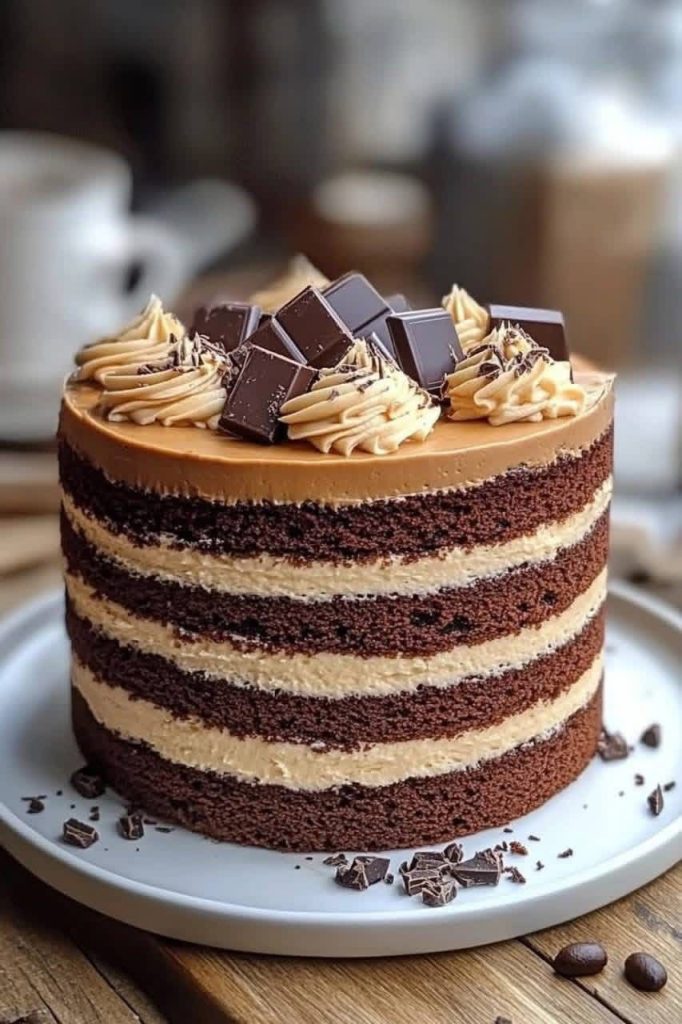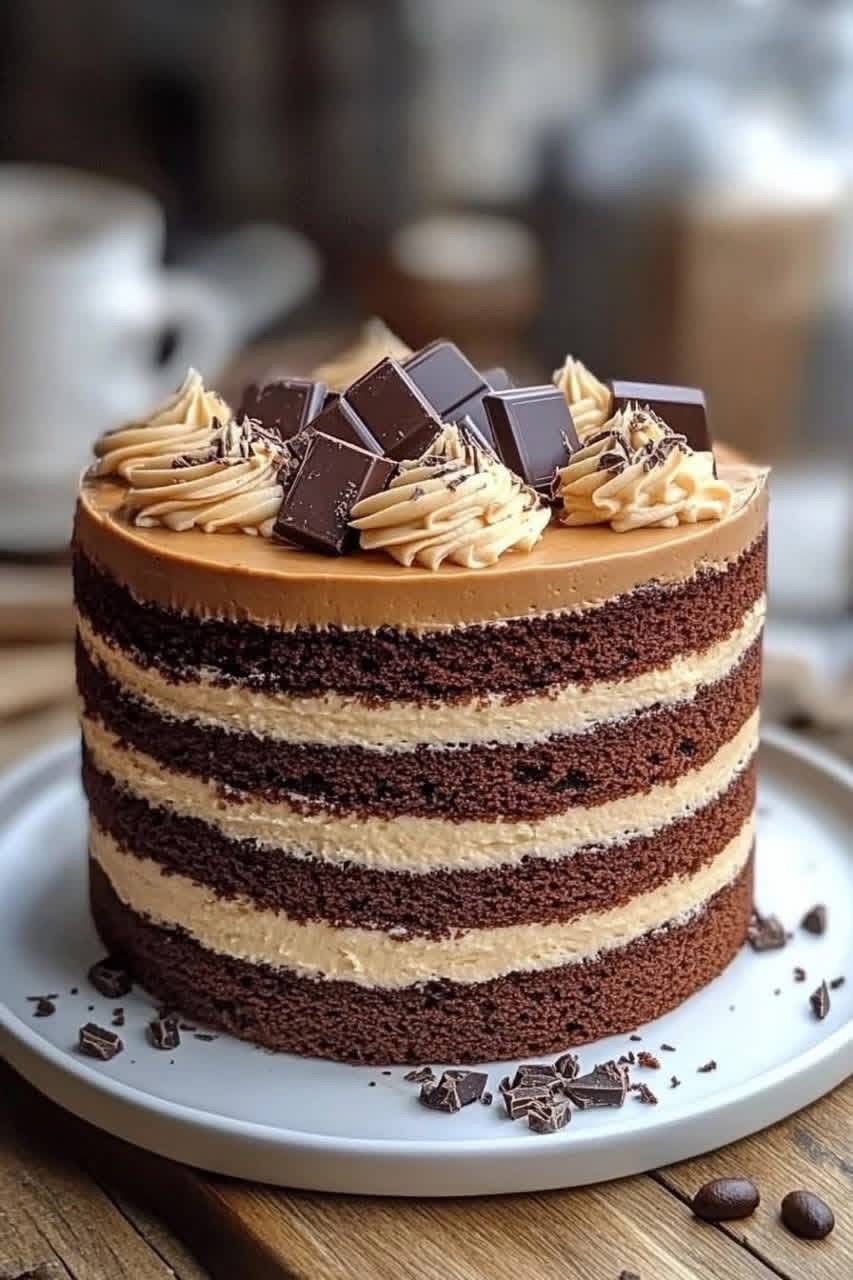Ingredients
For the sponge cake:
- 2 cups all-purpose flour
- 1 ¾ cups granulated sugar
- ¾ cup unsweetened cocoa powder
- 2 teaspoons baking powder
- 1 ½ teaspoons baking soda
- ½ teaspoon salt
- 1 teaspoon instant coffee granules
- 1 cup milk
- ½ cup vegetable oil
- 2 large eggs
- 2 teaspoons vanilla extract
- 1 cup freshly brewed hot coffee
For the coffee buttercream:
- 1 cup unsalted butter, softened
- 3 cups powdered sugar
- 2 tablespoons instant coffee dissolved in 1 tablespoon hot water
- 1 teaspoon vanilla extract
- 2 tablespoons heavy cream or milk
For decoration (optional):
- Chocolate shavings or curls
- Chocolate pieces or blocks
Instructions
- Preheat and prepare pans
Preheat your oven to 350°F (175°C). Grease and line three 8-inch round cake pans with parchment paper. - Prepare the batter
In a large mixing bowl, sift together the flour, sugar, cocoa powder, baking powder, baking soda, salt, and coffee granules. In another bowl, whisk together the milk, oil, eggs, and vanilla extract until combined. Add the wet ingredients to the dry mixture and stir until smooth. Gradually add the hot coffee and mix until the batter is thin and well incorporated. - Bake the cakes
Divide the batter evenly between the prepared pans. Bake for 25–30 minutes or until a toothpick inserted into the center comes out clean. Let the cakes cool in the pans for 10 minutes, then transfer to wire racks to cool completely. - Prepare the coffee buttercream
In a large bowl, beat the softened butter until light and fluffy. Gradually add the powdered sugar, one cup at a time. Mix in the dissolved coffee and vanilla extract. Add the cream or milk one tablespoon at a time until the buttercream reaches a smooth, spreadable consistency. - Assemble the cake
Once the cake layers have cooled, level them if necessary. Place the first layer on a cake board or serving plate. Spread an even layer of coffee buttercream on top. Repeat with the remaining layers. Use more buttercream to cover the top and sides if desired, or leave the sides exposed for a naked cake look. - Decorate
Decorate the top with piped buttercream swirls and place chocolate pieces or shavings on top. Chill slightly to set before serving.
Coffee and Chocolate Sponge Cake: Full Background and Insights
Coffee and chocolate have long been regarded as a natural flavor pairing. Their rich, deep profiles complement one another with perfect harmony. While coffee brings bold and slightly bitter undertones, chocolate contributes smooth sweetness and complexity. When these two flavors are integrated into a sponge cake, they create an indulgent dessert that satisfies a variety of palates. This cake is perfect for celebrations, afternoon teas, birthdays, or simply when one desires a sophisticated dessert.
The combination of coffee and chocolate in baking is not a modern invention. Historical records reveal that as far back as the early 20th century, European bakers experimented with mocha-flavored desserts. In many cultures, particularly in French, Italian, and American baking traditions, coffee and chocolate were often featured in layered tortes, opera cakes, and other luxurious pastries.
The sponge cake in this recipe is designed to be moist, light, and richly flavored without being overly dense. The use of hot coffee in the batter not only enhances the chocolate taste but also helps activate the cocoa powder, deepening its flavor. Moreover, the addition of instant coffee granules in the dry ingredients ensures that the coffee note is pronounced and well-distributed throughout the cake.
What sets this sponge apart is its texture. Achieving a perfect sponge requires balance. Overmixing the batter can lead to a tough or dry cake, while undermixing can result in an uneven texture. By carefully combining the wet and dry ingredients and incorporating the coffee last, the structure of the batter remains intact while still providing a moist and tender crumb.

The coffee buttercream adds another layer of flavor and smoothness. Buttercream frosting is a classic choice for layered cakes due to its creamy consistency and ease of spreading. In this version, coffee is introduced by dissolving instant granules in water before blending into the butter. This method ensures a uniform distribution of flavor and prevents gritty texture. Powdered sugar gives the frosting its structure and sweetness, while a splash of cream improves the spreadability and mouthfeel.
When building a layered cake, it is crucial to ensure each layer is level to maintain structural integrity. Using a serrated knife or cake leveler, bakers can trim the tops of the cakes to remove domes. This creates flat, even surfaces that make stacking easier and improve the visual appeal of the finished product.
As for presentation, the cake can be left semi-naked, revealing the beautiful contrast between dark sponge and light buttercream, or fully frosted for a more polished look. The final decoration is an opportunity to be creative. Chocolate curls or blocks placed on top add a visual element and hint at the flavors within. For a more elaborate effect, chocolate ganache or edible coffee beans can be added. A light dusting of cocoa powder or espresso powder is another elegant touch.
This cake can be made in advance and stored in the refrigerator for a few days. It should be brought to room temperature before serving to allow the buttercream to soften. For longer storage, the unfrosted cake layers can be frozen, tightly wrapped in plastic wrap and aluminum foil.
Pairing this dessert with beverages can further elevate the experience. A cup of espresso, cappuccino, or strong black coffee will echo the flavors of the cake, while a glass of cold milk provides a pleasant contrast. For a more indulgent pairing, a dessert wine such as port or a creamy liqueur like Baileys can complement the richness of the cake.
While the traditional version uses dairy and gluten-based ingredients, this recipe can be adapted for various dietary needs. Plant-based milk such as almond or oat milk can replace dairy milk, and vegan butter can substitute for dairy butter in the frosting. For a gluten-free version, use a 1:1 gluten-free baking flour blend. These modifications maintain the flavor integrity while making the cake accessible to those with dietary restrictions.
The success of a cake like this depends on quality ingredients. Use fresh, good-quality cocoa powder for the richest chocolate flavor, and choose a bold instant coffee for a stronger coffee profile. The butter should be high in fat content for the smoothest frosting texture.
In conclusion, the coffee and chocolate sponge cake is a refined dessert that brings together two of the most beloved flavors in baking. It represents a balance of textures and tastes that are both satisfying and memorable. With its moist sponge, smooth buttercream, and elegant presentation, it is a dessert suitable for a variety of occasions. The preparation process, while requiring attention to detail, is straightforward and rewarding. Once mastered, this cake can serve as a versatile base for countless variations, including mocha hazelnut, chocolate espresso, and tiramisu-inspired versions.
